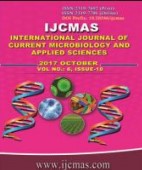


 National Academy of Agricultural Sciences (NAAS)
National Academy of Agricultural Sciences (NAAS)

|
PRINT ISSN : 2319-7692
Online ISSN : 2319-7706 Issues : 12 per year Publisher : Excellent Publishers Email : editorijcmas@gmail.com / submit@ijcmas.com Editor-in-chief: Dr.M.Prakash Index Copernicus ICV 2018: 95.39 NAAS RATING 2020: 5.38 |
The aim of the study was to determine the commonly isolated aerobic microorganisms found in pus samples and their antibiotic sensitivity pattern. This study was conducted in the Government Medical College Hospital, Thoothukudi from January to December 2016. Pus samples received from various departments are processed by standard protocols. Antibiotic susceptibility was done by Kirby Bauer disc diffusion method. Among 1575 pus samples received for culture and sensitivity in the microbiology laboratory, 1126 (71.49%) samples yielded positive culture and there was no growth in 449 (28.51%) samples. Among the 1126 culture positive cases 665 (59.06%) were male and 461 (40.94%) were female and the male: female ratio is 1.44.Klebsiella species was predominantly isolated 253 (22.5 %) followed by Staphylococcus aureus was 208 (18.5%), Escherichia coli was 194 (17.2%), Pseudomonas aeruginosa was 178 (15.8%), Proteus species was 166 (14.7%), Citrobacter species was 33 (2.9%), Acinetobacter species was 30(2.7%), Coagulase Negative Staphylococcal species 55 (4.9%), Enterococci species was 9 (0.8%). Gram Negative bacteria were mostly susceptible to Amikacin, Piperacillin Tazobactum, Ceftazidime-clavulanic acid, Cefaperazone sulbactum and Imipenem whereas Gram positive organisms show 100% sensitivity to Vancomycin and linezolid. In this study, about 54% of the isolates were ESBL producers. The incidence of ESBL isolates were high in Escherichia coli (60%) followed by Klebsiella species (56%), Pseudomonas aeruginosa (51%), Acinetobacter sp (50%), Citrobacter species (52%), Proteus species (49%) among Gram Negative Bacilli. MRSA isolated were 41% of Staphylococcus aureus and 49% of Coagulase negative Staphylococcal species. The study gives the bacterial profile in the wound infections and its sensitivity pattern which is very important for clinicians to start empirical treatment for patients, while culture reports are awaited. This study suggests reserving carbapenem drugs for critically ill patients as the antibiotic pipeline is already dry.
 |
 |
 |
 |
 |